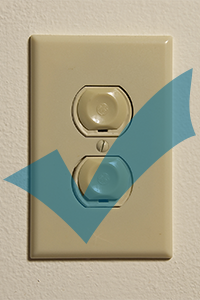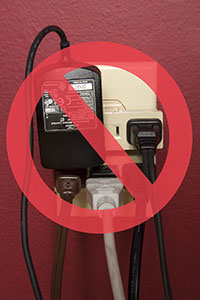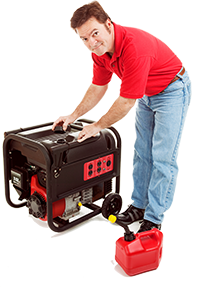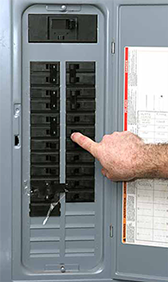


SEARCH MyCVEC
In-Home Safety
Do you know why these pictures are good or bad?
 It's never a good idea to overload circuits ...
It's never a good idea to overload circuits ...
thus a big NO to too many plugs in one outlet.
![]() Tamper resistant or child proof receptacles
Tamper resistant or child proof receptacles
are an excellent idea in any home where
young children live or visit.



![]()
Child Proof Receptacles
As of 2008, all new and renovated dwellings require receptacles with a built in safety feature ... if a child attempts to insert an object in one outlet only, there is no contact with electricity. Two prongs must be inserted at once to trip a spring-loaded feature. Any qualified electrician could easily change out outlets if you live in an older home and have children at risk.
There's more info about these TR receptacles here (PDF).
![]()
Electrical Cord Safety
 Extension cords, with their ability to bring any appliance or lamp within easy reach of an electrical outlet, are one of the most convenient products in the home. But when they are misused, they can also be a potential source of danger.
Extension cords, with their ability to bring any appliance or lamp within easy reach of an electrical outlet, are one of the most convenient products in the home. But when they are misused, they can also be a potential source of danger.
Choosing the right cord for the job:
![]() Extension cords are generally rated in amps and volts. To determine if an extension cord is properly rated, add the total wattage of each bulb or electrical device, then divide by 120 to calculate the total number of amps. If the total number of amps is equal to or greater than the maximum rating of the cord, you must use a higher rated extension cord.
Extension cords are generally rated in amps and volts. To determine if an extension cord is properly rated, add the total wattage of each bulb or electrical device, then divide by 120 to calculate the total number of amps. If the total number of amps is equal to or greater than the maximum rating of the cord, you must use a higher rated extension cord.
![]() Larger appliances and power tools use cords with three prongs, or conductors, one of which is the ground wire.
Larger appliances and power tools use cords with three prongs, or conductors, one of which is the ground wire.
![]() Before buying any extension cord, check the product to ensure that a nationally recognized laboratory, such as CSA, UL, or ETL, has certified the product.
Before buying any extension cord, check the product to ensure that a nationally recognized laboratory, such as CSA, UL, or ETL, has certified the product.
![]() Outside the home, only use extension cords designed for outdoor use.
Outside the home, only use extension cords designed for outdoor use.
![]() Choose a replacement cord with the correct insulation:
Choose a replacement cord with the correct insulation:
![]() Electric space heaters, for example, are required to use cords with a thermosetting insulation to prevent the cord from melting. Look for the letter "H" on the cord.
Electric space heaters, for example, are required to use cords with a thermosetting insulation to prevent the cord from melting. Look for the letter "H" on the cord.
![]() Lamp cords are usually flat, and the individual conductors parallel to each other. This type of cord is limited to indoor use and light duty.
Lamp cords are usually flat, and the individual conductors parallel to each other. This type of cord is limited to indoor use and light duty.
![]() Appliance cords are usually round and have larger diameters because they are made using two layers of insulation over the copper conductors. The individual conductors are insulated and a second layer of insulation, called a jacket, is also applied.
Appliance cords are usually round and have larger diameters because they are made using two layers of insulation over the copper conductors. The individual conductors are insulated and a second layer of insulation, called a jacket, is also applied.
![]() Replace older extension cords if one of the prongs in the plug is not “polarized.” In a polarized plug, one prong will be wider than the other.
Replace older extension cords if one of the prongs in the plug is not “polarized.” In a polarized plug, one prong will be wider than the other.
Never …
… run extension cords through walls, under rugs or furniture, or across doorways.
… try to repair a damaged extension cord with electrical tape; replace it.
… overload an extension cord. If any part of the cord feels warm to the touch, the cord is drawing too much power and could cause a fire or shock hazard.
… cut off the ground pin to connect a 3-prong appliance cord to a 2-wire extension cord or receptacle. Always use a CSA, UL or ETL listed adapter for this purpose.
… place cords where someone could accidentally pull them down or trip over them.
… leave unused outlets on the extension cord exposed to prevent children from making contact with a live circuit. Seal with attachment made for closing them off.
![]()
Portable Generator Safety
Take special care with portable electric generators, which can provide a good source of power, but if improperly installed or operated, can become deadly.
Do not connect generators directly to household wiring. Power from generators can back feed along power lines and electrocute anyone coming in contact with them, including line workers making repairs.
A qualified, licensed electrician should install your generator to ensure that it meets local electrical codes.
electrical codes.
Other tips include:
![]() Make sure your generator is properly grounded.
Make sure your generator is properly grounded.
![]() Keep the generator dry.
Keep the generator dry.
![]() Plug appliances directly into the generator.
Plug appliances directly into the generator.
![]() Make sure extension cords used with generators are rated for the load, and are free of cuts, worn insulation, and have three-pronged plugs.
Make sure extension cords used with generators are rated for the load, and are free of cuts, worn insulation, and have three-pronged plugs.
![]() Do not operate the generator in enclosed or partially enclosed spaces. Generators can produce high levels of carbon monoxide very quickly, which can be deadly.
Do not operate the generator in enclosed or partially enclosed spaces. Generators can produce high levels of carbon monoxide very quickly, which can be deadly.
![]() Use a ground fault circuit interrupter (GFCI) to help prevent electrocutions and electrical shock injuries. Portable GFCIs require no tools to install and are available at prices ranging from $12 to $30.
Use a ground fault circuit interrupter (GFCI) to help prevent electrocutions and electrical shock injuries. Portable GFCIs require no tools to install and are available at prices ranging from $12 to $30.
Info about Standby Whole House Generators can be found here.
![]()
Know Your Home System
 Electrical hazards are the major cause of home and workplace fatalities. Contact with large appliances, such as air conditioners, contributes to nearly 20 percent of consumer product electrocutions.
Electrical hazards are the major cause of home and workplace fatalities. Contact with large appliances, such as air conditioners, contributes to nearly 20 percent of consumer product electrocutions.
Whether at home or in the work place, there are a number of safety precautions that can reduce the chance of deaths, injuries and economic losses due to electrical hazards.
![]() Use ground fault circuit interrupters (GFCIs) to help prevent electrocutions.
Use ground fault circuit interrupters (GFCIs) to help prevent electrocutions.
![]() Understand your electrical system --- know which fuse or circuit breaker controls each switch, light and outlet.
Understand your electrical system --- know which fuse or circuit breaker controls each switch, light and outlet.
![]() Make sure circuits are turned off before starting work, and take measures to make sure they are not turned back on while working.
Make sure circuits are turned off before starting work, and take measures to make sure they are not turned back on while working.
![]() Use a circuit tester. Make sure it is working by testing it before and after you use it to test the circuit.
Use a circuit tester. Make sure it is working by testing it before and after you use it to test the circuit.
![]() Always test before you touch.
Always test before you touch.
Home
HOME | REPORT AN OUTAGE | PAY MY BILL | CONTACT CVEC
Phone: 434.263.8336 | Toll free: 800.367.2832 | Fax: 434.263.8339
Corporate Headquarters:
800 Cooperative Way
Arrington, VA 22922
Payments:
Dept. 1340 | PO Box 2153
Birmingham, AL 35287-1340
Correspondence:
P. O. Box 247
Lovingston, VA 22949
